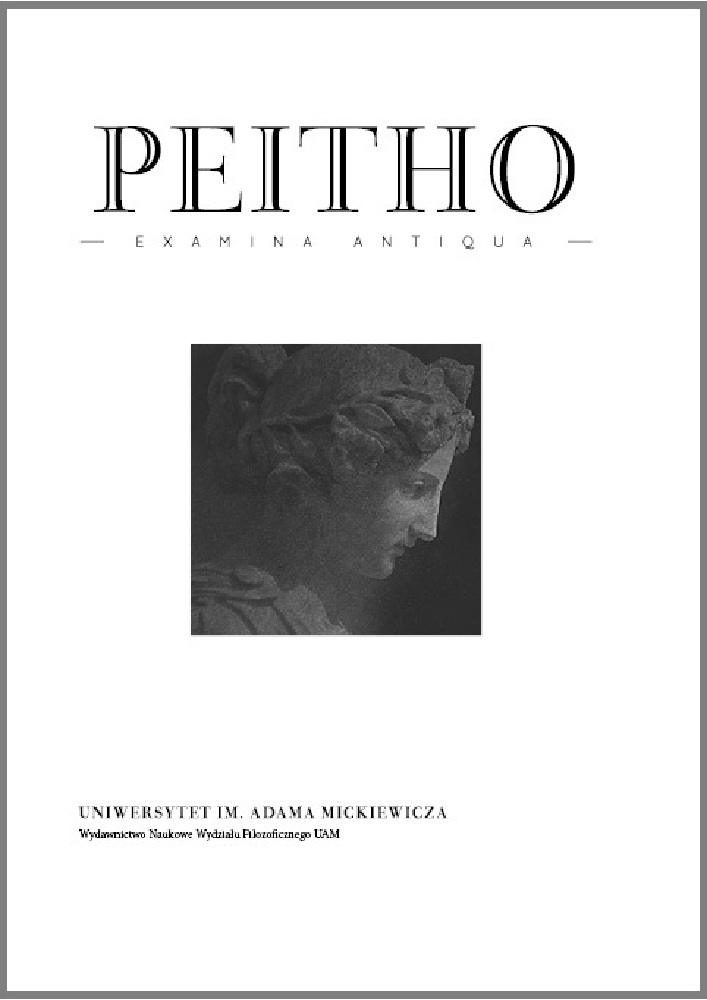Abstract
The present paper focuses on some aspects of the Neoplatonist literary-metaphysical theory, which has clearly been expressed in the anonymous Prolegomena to Plato’s philosophy and further confirmed in Proclus’ exegesis of the Timaeus. Thus, this contribution, examines and compares several passages from the Prolegomena and from Proclus’ Commentary on the Timaeus with a view to showing that it is legitimate to speak of a certain cosmogony of the Platonic dialogue that is analogous to that of the macrocosm. Moreover, the analogy between macrocosm and microcosm makes it possible to further investigate the similarity between the λόγος-ζῷον of the Demiurge and that of Timaeus, on the one hand, and the reality which the λόγος expresses, on the other. This similarity turns out to be both structural/morphological and content-related/semantic. Thus, by combining the natural and theological science, the analysis of the “generation” of the macrocosm and microcosm brings out the strongly analogical nature of Plato’s dialogues, which is particularly visible in the Timaeus.
References
Barnes, J., Griffin, M. (eds.), 1997, Philosophia Togata II. Plato and Aristotle at Rome, Oxford.
Brisson, L., 1982, Platon. Les mots et les mythes, Paris.
Brisson, L., 1987, Le discours comme univers et l’univers comme discours, in: M. Costantini , J. Lallot, A. Le Boulluec (éd.), Le texte et ses représentations, Paris, pp. 121–128.
Brittain, C., 2001, Philo of Larissa. The Last of the Academic Sceptic, Oxford.
Chantraine, P., 1999, Dictionnaire étymologique de la langue grecque. Histoire des mots, Paris.
Cleary, J. J., 2006, Proclus as a Reader of Plato’s Timaeus, in: H. Tarrant, D. Baltzly (eds.), Reading Plato in Antiquity, London.
Cornford, F. M., 1956, Plato’s Cosmology, London.
Coulter, J. A., 1976, The Literary Microcosm. Theories of Interpretation of the Later Neoplatonists, Leiden.
Dalsgaard Larsen, B., 1972, Jamblique de Chalcis, exégète et philosophe, Aarhus.
Dillon, J., 1973, Iamblichi Chalcidensis in Platonis Dialogos Commentaria, Leiden.
Dillon, J., 2000, The Role of the Demiurge in the Platonic Theology, in: A. A.-Ph. Segonds, C. Steel (eds.), Proclus et la Théologie platonicienne, Leuven–Paris, pp. 339–349.
Donini, P., 2010, I fondamenti della fisica e la teoria delle cause in Plutarco, in: M. Bonazzi (ed.), Commentary and Tradition. Aristotelianism, Platonism, and Post-Hellenistic Philosophy, Berlin–New York, pp. 341–357.
Dörrie, H. (hrsg.), 1987, Der Platonismus in der Antike. Bd. 1: Die geschichtlichen Wurzeln des Platonismus, Stuttgart–Bad Cannstatt.
Dörrie, H., 1969, “Praepositionen und Metaphysik“, Museum Helveticum 26, pp. 217–228.
Dörrie, H., 1974, “Zur Methodik antiker Exegese“, Zeitschrift für die Neutestamentliche Wissenschaft 65, pp. 121–138.
Dörrie, H., Baltes, M. (hrsg.), 1996, Der Platonismus in der Antike. Bd. 4: Die philosophische Lehre des Platonis¬mus. Einige grundlegende Axiome / Platonische Physik (im antiken Verständnis) I, Stuttgart–Bad Cannstatt.
Ferrary, J.-H., 1988, Philhellénisme et impérialisme, Rome.
Gersh, S., 2003, Proclus’ Commentary on the Timaeus – Prefatory Material, in: R. W. Sharples, A. Sheppard (eds.), Ancient Approaches to Plato’s Timaeus, London, pp. 143–153.
Glucker, J., 1978, Antiochus and the Late Academy, Göttingen.
Hadot, I. (ed.), 1990, Simplicius, Commentaire sur les Catégories d’Aristote, vol. 1, Leiden–New York.
Helmig, Ch., 2012, Forms and concepts: concept formation in the Platonic tradition, Berlin.
Kutash, E., 2011, The Ten Gifts of the Demiurge. Proclus’ Commentary on Plato’s Timaeus, London–New York.
Lang, H. S., Macro, A. D. (eds.), 2001, On the Eternity of the World. De aeternitate Mundi. Proclus, Berkeley– Los Angeles–London.
Lernould, A., 2001, Physique et théologie: lecture du Timée de Platon par Proclus, Villeneuve d’Ascq.
Lernould, A., 2010, Le « but » et le « caractère » du Timée dans l’In Timaeum de Proclus. La fonction herméneu¬tique des κεφάλαια énumérés dans les prologues aux commentaires néoplatoniciens, in: A. Neschke-Hentschke (hrsg.), Argumenta in dialogos Platonis, Teil 1: Platoninterpretation und ihre Hermeneutik von der Antike bis zum Beginn des 19. Jahrhunderts, Basel, pp. 149–181.
Mansfeld, J., 1994, Prolegomena. Questions to be settled before the study of an author, or a text, Leiden–New York–Köln.
Martijn, M., 2006, The eikôs mythos in Proclus’ Commentary on the Timaeus, in: H. Tarrant, D. Baltzly (eds.), Reading Plato in Antiquity, London, pp. 151–167.
Martijn, M., 2010, Proclus on Nature. Philosophy and Its Methods in Proclus’ Commentary on Plato’s Timaeus, Leiden–Boston.
Motta, A. (cur.), 2014, Anonimo. Prolegomeni alla filosofia di Platone, Roma.
Motta, A., 2018, λόγους ποιεῖν. L’eredità platonica e il superamento dell’aporia dei dialoghi, Napoli.
Motte, A., 2000, Discours théologique et prière d’invocation. Proclus héritier et interprète de Platon, in: A.-Ph. Segonds, C. Steel (eds), Proclus et la Théologie platonicienne, Leuven–Paris, pp. 91–108.
Neschke-Hentschke, A., 2000, Der platonische Timaios als Manifest der platonischen Demiurgie, in: A. Neschke-Hentschke (ed./hrsg.), Le Timée de Platon. Contributions à l’histoire de sa réception / Platos Timaios. Beiträge zu seiner Rezeptionsgeschichte, Louvain-la-neue–Louvain–Paris, pp. ix–xxvii.
Plezia, M., 1949, De commentariis Isagogicis, Kraków.
Radke-Uhlmann, G., 2006, Das Lächeln des Parmenides. Proklos’ Interpretationen zur Platonischen Dialogform, Berlin.
Reydams-Schils, G. J. (ed.), 2003, Plato’s Timaeus as Cultural Icon, Notre Dame IN.
Runia, D. T., 1997, The Literary and Philosophical Status of Timaeus’ Prooemium, in: T. Calvo, L. Brisson (eds.), Interpreting the Timaeus / Critias, Sankt Augustin.
Runia, D. T., Share, M. (eds.), 2008, Commentary on Plato’s Timaeus, vol. II, Book 2: Proclus on the Causes of the Cosmos and its Creation, Cambridge.
Steel, C., 2003, Why should we prefer Plato’s Timaeus to Aristotle’s Physics? Proclus’ Critique of Aristotle’s Caus¬al Explanation of the Physical World, in: R. W. Sharples, A. Sheppard (eds.), Ancient Approaches to Plato’s Timaeus, London, pp. 175–187.
Tarrant, H. (ed.), 2007, Proclus. Commentary on Plato’s Timaeus, vol. I, Book 1: Proclus on the Socratic State and Atlantis, Cambridge.
Trouillard, J., 1982, La mystagogie de Proclos, Paris.
Tzamalikos, P., 2016, Anaxagoras, Origen, and Neoplatonism. The Legacy of Anaxagoras to Classical and Late Antiquity, Berlin–Boston.
Westerink, L. G. (ed.), 1962, Anonymous Prolegomena to Platonic Philosophy, Amsterdam.
Westerink, L. G., Trouillard, J., A.-Ph. Segonds, 1990, Anonyme. Prolégomènes à la philosophie de Platon, Paris 1990.
License
Peitho provides immediate open access to its content on the principle that making research freely available to the public supports a greater global exchange of knowledge.
